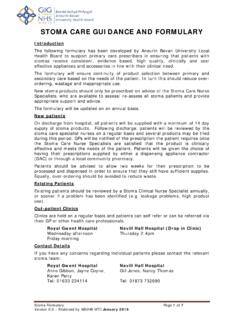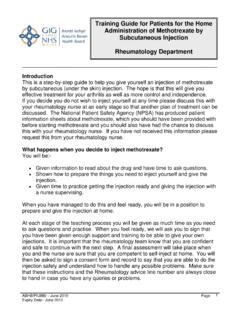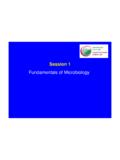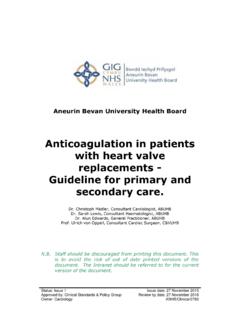Transcription of Chronic Cough - NHS Wales
1 Chronic Cough h gu uidance o on investigation,, manage ement an nd referrral AB. BHUB, Depaartment of Respiratoryy Medicine Chronic co ough is defined as one lasting more than eigh ht weeks It is reported in 10 200% of adults commoner in femaales and obeese Most pressent with a dry or minimally produ uctive Cough The presen nce of signifficant sputu um production usually indicates primary lungg pathology URRGENT REFEERRAL (Red d Flag Featu ures) If a cheest x ray suggests lung caancer includding effusion n or non resoolving consolidation Persisttent haemop ptysis, weightt loss, progreessive breath hlessness, siggns of superior vena cavaal obstructio on or stridorr Historyy of aspiratio on of a foreiggn body IF LUNG C. CANCER SUSSPECTED PLLEASE REFER TO RAPID.
2 D ACCESS LU. UNG CANCEER CLINIC Caauses of Chronic cou ugh: Moost commo on: Smokingg Asthma Chronicc obstructivee pulmonarry disease (C COPD) GORD Postnassal drip (inclluding allerggic rhinitis, vasomotor rhinitis) ACE inhibitors Whooping Cough Less common n: Chronicc lung infecttions: Bronchiectaasis, TB, Cysstic fibrosis,, lung absce ess Parenchhymal lung d disease: Interstitial llung diseasee (fibrosis), Sarcoid Cancer: Primary lun ng cancer, mmetastases tto the lung,, lymphomaas and other cancers caausing meadiastinal lymphadenopathy Upper aairway cond ditions: Obstructivee sleep apno oea, chronicc snoring, irrritation of tthe externaal meatus Cardio vvascular cau uses: Left ventriccular failure, arrhythmias, aortic aneurysm, pulmonary eemboli n B12 deficieency1 Vitamin Iron defficiency2 Thyroid dysfunction This is guideline is on nline at: 814&pid=48819.
3 9 Sta atus: APPROVED D Issue Date: June 2015 Approved by: ABUHB M MTC Page 1 of 6 Review Date: June 2018. Where a Cough is Chronic with no obvious features pointing to an underlying disease, the commonest causes of a Chronic Cough are: Gastro oesophageal reflux related Cough [37%] Asthma and asthma like syndromes [33%] See diagnostic algorithm on page 3 Rhinitis, sinusitis, post nasal drip [10%] Specific considerations: ACE Inhibitor therapy: 16% of patients on these drugs develop Cough , for the majority of patients with ACE associated Cough this improves within 1 month of cessation of ACE inhibitors. ARB's are a rare cause of Cough and may be used instead of ACE inhibitors. Smoking: Cough frequency is related to the number of cigarettes smoked Smoking cessation is an important and effective intervention It is not uncommon for a number of causes to be present at the same time Characteristics of Cough / associations Talking, laughing, singing precipitates Cough Gastro oesophageal Associated metallic taste in the mouth reflux related Cough Worse on bending, lying Eases at night (worse during the day, present on rising) Dyspepsia, present on eating or ~10 minutes after eating o Chronic nasal congestion Rhinitis / Post.
4 O Catarrhal symptoms and persistent throat clearing nasal drip o Mucous at the back of the throat Nocturnal Cough Onset on exercise Peripheral blood eosinophilia Associated wheeze, dyspnoea Asthma and Reversibility/airflow obstruction on spirometry Asthma like (NB. The absence of this does not exclude asthma or syndromes asthma like syndromes) All patients with unexplained Cough should have the following tests as a minimum Chest x ray Spirometry (with reversibility) Serial peak flow readings This guideline is online at: Status: APPROVED Issue Date: June 2015 Approved by: ABUHB MTC Page 2 of 6 Review Date: June 2018 This guideline is online at: Status: APPROVED Issue Date: June 2015 Approved by: ABUHB MTC Page 3 of 6 Review Date: June 2018 Supporting information.
5 Chronic Cough is a common presenting complaint, patients are often concerned about Chronic Cough being due to lung cancer, however this is a relatively uncommon cause accounting for less than 2% of patients presenting with Chronic It is important to reassure patients that for the majority Chronic Cough is not a symptom of cancer. One review found that out of 77 patients diagnosed with lung cancer who presented with Cough as one of their main symptoms had an x ray which was reported as normal, and a further had an abnormal chest x ray where lung cancer was not suspected3. If clinical suspicion is high that a patient may have lung cancer referral to the rapid access lung cancer service is recommended. ACE inhibitor associated Cough : Generally resolves 1 4/52 after cessation of an ACE inhibitor but can take up to 3 months.
6 ARBs are only rarely associated with Cough and if indicated an ACE can be swapped to an ARB5. As ACE inhibitors are thought to lower the threshold of Cough receptors ACE inhibitors should be avoided in any patient complaining of a Chronic Cough . Smoking and Chronic Cough : There is a dose response effect seen for number of cigarettes smoked and cough6, generally Cough improves and may resolve within about 1 3 months after stopping smoking. Asthma and asthma type syndromes and Chronic Cough : Cough variant asthma, asthma and eosinophilic bronchitis are all associated with Chronic Cough . Cough may be the only symptom, particularly in eosinophilic bronchitis where there is often a lack of measurable airflow obstruction and/or diurnal variation. No test has sufficient sensitivity or specificity to exclude asthma or asthma type syndromes as a cause of Chronic cough7.
7 Cough may be the first symptom of asthma and may present months or years before patients exhibit more classic symptoms of asthma (wheeze, reversible airflow obstruction etc). Treatment recommendations: First line would be a two month trial of 400 micrograms of budesonide (or equivalent) as this is the recommended starting dose for the treatment of eosinophilic bronchitis8. It is vital to ensure patients are taught how to correctly use an inhaler, and in terms of delivery device the recommendation would be a dry powder inhaler or an MDI via an aerochamber or volumatic. Some patients may find that paradoxically their Cough worsens with inhaled therapy this is generally due to poor technique or a constituent in the aerosol, use of an alternative delivery device should be considered, or a volumatic or Where there is a partial response or no response stepping up to a combination inhaler with 400 micrograms of budesonide (or equivalent) plus long acting beta agonist for a further two month trial is recommended.
8 This guideline is online at: Status: APPROVED Issue Date: June 2015 Approved by: ABUHB MTC Page 4 of 6 Review Date: June 2018 Where there is doubt about a patients compliance with inhaled therapy or potential treatment resistance then a 2 week trial of 30 mg of oral corticosteroids can be considered10 In patients whose Cough successfully responds to inhaled corticosteroids consider stepping down inhaled therapy after 3 months, as you would in patients whose asthma is well controlled. Postnasal drip (PND)/rhinitis PND refers to the sensation of nasal secretions at the back of the throat (or of a drip'), often resulting in the need to clear the throat and is associated with nasal stuffiness or nasal discharge. Sometimes, the patient may describe the sensation of something running down the back of the throat'.
9 It is also often referred to as nasal catarrh' or mucus in the throat' by patients in the UK. There are numerous rhinological conditions that can give rise to PND including allergic, non allergic (vasomotor) and infective rhino sinusitis. Allergic rhinitis responds well to intranasal steroids +/ antihistamines either nasally or orally. Non allergic rhinitis especially if rhinorrhoea is a predominant feature may respond to ipratropium bromide intranasally11 in addition to nasal steroids. Oral antihistamines are generally ineffective in non allergic rhinitis however intranasal antihistamines especially azelastine is effective in non allergic rhinitis11 The following may be trialled either altogether12 or in a stepwise fashion in patients where post nasal drip appears to be a trigger for their Cough , but other intranasal therapies have not been successful12.
10 1) Intranasal steroid once a day nasal steroids are recommended to aid compliance. 2) Intranasal antihistamine 3) Intranasal Ipratropium bromide Oral antihistamines: Older generation sedating antihistamines are lipophilic and so cross the blood brain barrier and may be helpful in supressing a central component to Cough . Additionally with the older agents It is well recognised that they have anticholinergic properties13 Reflux associated Cough Observational studies suggest a link between Chronic Cough and reflux. Two mechanisms have been proposed to explain why people with GORD develop Chronic Cough . The most intuitive theory is called the reflux theory, whereby reflux rises above the esophagus and upper oesophageal sphincter, resulting in microaspiration as microdroplets land in the larynx or occasionally enter the bronchial tree, directly causing Cough as a protective mechanism against reflux.












